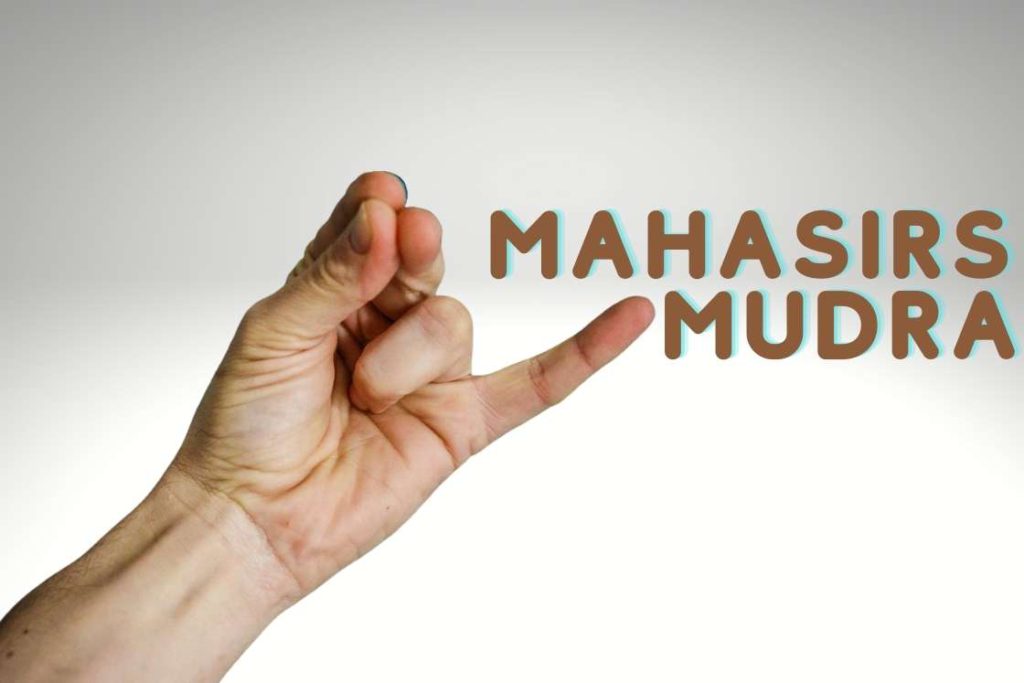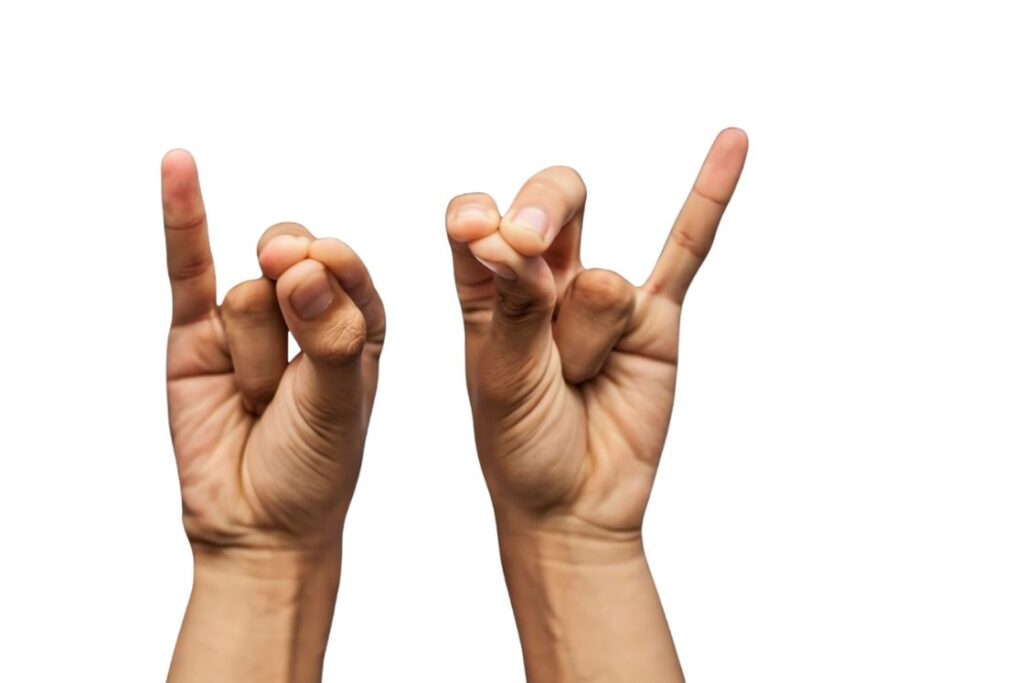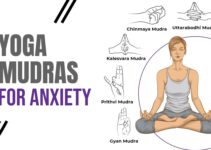
Mahasirs Mudra, also known as the “Gesture of the Great Head,” is a powerful hand gesture used in yoga and Ayurveda to promote mental clarity and alleviate various ailments, particularly those affecting the head.
This mudra is believed to balance the Vata and Kapha doshas, helping to relieve sinus issues, eye strain, and tension headaches. By incorporating Mahasirs Mudra into your daily routine, you can experience improved concentration, reduced stress, and overall enhanced well-being.
Learn about the relieving effects of Mahasirs Mudra and the mechanism behind it by staying with this post for a while.
Mahasirs mudra meaning
Have a look into the etymology of the name given to this mudra, it is composed of the following root terms:
- “Maha” refers to “great”
- “Siris” means “head”
- “Mudra” is “gesture or seal”
Mahasirs Mudra has relieving effects on the head region, whether for aches or tensions; hence the name. It is translated as the “Gesture of the Great Head.”
Eliminate all the reasons for your headache by performing this simple hasta mudra.
This post serves as a practice guide for Mahasirs Mudra for everyone who occasionally experiences a heavy head.
How to do mahasirs mudra (Steps)

- Sit in a comfortable meditative position or on a chair.
- Loosen up your shoulder and relax the whole body taking a deep breath in and exhaling out.
- Place your hands on your thighs with palms facing up.
- Bring the tips of thumb, index, and middle fingers together pointing upward.
- Curl the ring finger towards the base of the thumb.
- Extend the little finger towards the ceiling.
- Assume this gesture on both hands.
- Inhale deeply filling the air into the belly then exhale out.
- Observe the rise and fall of the belly.
- Practice it for six minutes and then relax for a while.
How long to do mahasirs mudra?
Practice mahasirs mudra for 30-40 minutes, either in one stretch or in multiple sessions of 10-15 minutes each. For best results, aim for at least 20 minutes of continuous practice. Morning (4 am to 6 am) for best concentration and effectiveness. Evening practice is also beneficial.
Note: Mahasirs Mudra is best performed at the end of alternate nostril breathing or Anulom Vilom Pranayama. It helps to clear out your sinuses.
How mahasirs mudra works?
Headaches are a common health condition experienced by people of all ages and genders. In Ayurveda, headaches are attributed to imbalances in the doshas, particularly Vata and Pitta.
Each dosha is linked to one or more of the Panchatattvas (five elements) in the body. Vata is associated with air and ether elements, while Pitta is connected to fire and water elements.
Mahasirs Mudra helps alleviate headaches by balancing and regulating the interplay of these doshas and elements.
Mechanism of mahasirs mudra
- Index Finger (Air) and Middle Finger (Ether): These are joined with the Thumb (Fire). Although air and ether cannot be set on fire, combining them with fire warms and calms these elements, which is beneficial for headaches caused by a cold.
- Ring Finger (Earth): Curled towards the Thumb’s base (Fire) produces a grounding effect. This helps balance excess fire, which can be a cause of headaches due to overstimulation.
- Little Finger (Water): Extended upwards symbolizes water flowing through the body. This provides a cooling and calming effect, easing the heaviness and discomfort of a headache.
By aligning and regulating these elements through the hand gesture, Mahasirs Mudra creates a balancing effect that addresses both cold-induced and overstimulated headaches.
Variations for Relieving Tension
Mahasirs Mudra can also be adapted by altering the hand position from the thighs:
- Fingertips Touching the Ground: Position the hands so that the fingertips touch the ground while maintaining the same finger arrangement. This variation promotes a sense of grounding, harmony, and reassurance, helping to relieve day-to-day tension and stress that can lead to headaches.
- Hands by the Side: Another slight variation involves positioning the hands by the sides of the body. This adjustment can also be beneficial for relieving tension.
- Lying Down: Mahasirs Mudra can be practiced while lying down on a bed or any comfortable surface. This position is especially helpful for deep relaxation and tension relief.
Precautions & Contraindications
- Maintain a comfortable meditative posture to prevent physical strain.
- Practice in moderation to avoid mental overstimulation; take breaks if necessary.
- Avoid practicing if you experience acute pain or injury in the hands or wrists.
- Practice the mudra in moderation to avoid mental overstimulation. Take breaks if needed.
Mahasirs mudra side effects
- Incorrect finger positioning or excessive tension may cause hand or finger discomfort.
- Some practitioners may experience mild headaches or discomfort initially. This is often temporary and may subside as you continue practice.
- If you feel dizzy or lightheaded, stop the practice and rest. Ensure you are practicing in a well-ventilated space.
- Prolonged or incorrect practice may result in physical strain or discomfort.
Benefits of Mahasirs Mudra
1. Cures sinus issues – According to Ayurveda, sinus problems are primarily caused by an imbalance between the Vata and Kapha doshas in the body. Holding Mahasirs Mudra helps restore balance between Vata and Kapha, alleviating mucus congestion and thus providing relief from sinus problems.
2. Relieves eye strain – By alleviating mental issues like stress, this mudra relaxes the brain and the nerves connected to the eyes. It provides a soothing effect to the eye muscles, especially when practiced during meditation sessions.
3. Improves concentration – Mahasirs Mudra enhances mental clarity and improves focus. This, in turn, aids in reaching a deeper meditative state.
4. Alleviates temporomandibular disorder – Mental stress can lead to headaches and create physical tension around the face, jaw, and eyes. Mahasirs Mudra helps relax the temporomandibular joint, which connects the lower jaw to the skull. As a result, it can be beneficial in reducing temporomandibular joint disorder.
Conclusion
Mahasirs Mudra is a versatile and effective practice that addresses headaches, stress, and sinus issues while promoting overall well-being. By dedicating a few minutes daily to this mudra, you can experience its therapeutic benefits, leading to a more balanced, relaxed, and spiritually enriched life.
FAQs related to Mahasirs Mudra
Join the tips of the thumb, index, and middle fingers, bend the ring finger towards the thumb’s base, and extend the little finger upwards. Repeat this with both hands.
Practice Mahasirs Mudra for 30-40 minutes daily, either in one continuous stretch or in multiple sessions of 10-15 minutes each. For best results, aim for at least 20 minutes of continuous practice.
The best time to practice is early morning, between 4 am and 6 am, but it can also be done in the evening if more convenient.
Yes, Mahasirs Mudra is believed to balance the energy in the head region, which can positively influence the crown chakra (Sahasrara) and third eye chakra (Ajna).
Mahasirs Mudra helps alleviate headaches by balancing the body’s energy and calming the mind, addressing issues related to sinus congestion, tension, and stress.
Possible side effects include hand or finger strain, mental overstimulation, or mild discomfort if the mudra is practiced incorrectly or excessively.





I have occipital pain since last 8 years in which there is continuous pain starting at the base of the skull going towards the eyes. It gets aggravated when I lay down on bed. Can you please suggest me which other mudras to perform along with Mahasir mudra to get instant and long term relief
I’m sorry to hear about your 8-year-long occipital pain. Alongside Mahasirs Mudra, you might find relief in trying Prana Mudra, Apana Vayu Mudra, and Gyan Mudra.